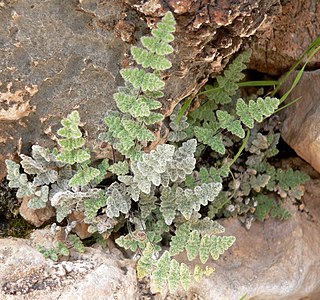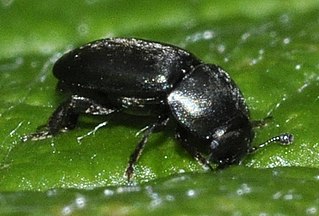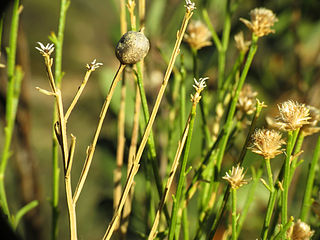
Cheilanthes is a genus of about 180 species of rock-dwelling ferns with a cosmopolitan distribution in warm, dry, rocky regions, often growing in small crevices high up on cliffs. Most are small, sturdy and evergreen. The leaves, often densely covered in trichomes, spring directly from the rootstocks. Many of them are desert ferns, curling up during dry times and reviving with the coming of moisture. At the ends of veins sporangia, or spore-bearing structures, are protected by leaf margins, which curl over them.
The plant pathogenic fungus Leucostoma kunzei is the causal agent of Leucostoma canker a disease of spruce trees found in the Northern Hemisphere, predominantly on Norway spruce and Colorado blue spruce. This disease is one of the most common and detrimental stem diseases of Picea species in the northeastern United States, yet it also affects other coniferous species. Rarely does it kill its host tree; however, the disease does disfigure by killing host branches and causing resin exudation from perennial lesions on branches or trunks.

Venturia is a genus of fungi in the family Venturiaceae. First identified in 1882, species in the genus are plant pathogens. Venturia is widespread and the genus contains an estimated 58 species. Anamorphs were historically represented in the genus Fusicladium.

Ramariopsis is a genus of coral fungi in the family Clavariaceae. The genus has a collectively widespread distribution and contains about 40 species. The name means 'having the appearance of Ramaria'.

Ramariopsis kunzei is an edible species of coral fungi in the family Clavariaceae, and the type species of the genus Ramariopsis. It is commonly known as white coral because of the branched structure of the fruit bodies that resemble marine coral. The fruit bodies are up to 5 cm (2.0 in) tall by 4 cm (1.6 in) wide, with numerous branches originating from a short rudimentary stem. The branches are one to two millimeters thick, smooth, and white, sometimes with yellowish tips in age. Ramariopsis kunzei has a widespread distribution, and is found in North America, Europe, Asia, and Australia.

Meligethes is a genus of pollen beetles in the family Nitidulidae. There are more than 80 described species in Meligethes.
Mallota bequaerti is a species of syrphid fly in the family Syrphidae.
Aneurus simplex is a species of flat bug in the family Aradidae. It is found in North America.
Aradus borealis is a species of flat bug in the family Aradidae. It is found in North America.
Largus pallidus is a species of bordered plant bug in the family Largidae. It is found in North America.
Aradus shermani is a species of flat bug in the family Aradidae. It is found in North America.
Aneurus borealis is a species of flat bug in the family Aradidae. It is found in North America.
Gozmanyina majestus is a species of cosmochthoniid in the family Cosmochthoniidae.
Phloeosinus pini is a species of crenulate bark beetle in the family Curculionidae. It is found in North America.
Kunzeana is a genus of leafhoppers in the family Cicadellidae. There are more than 30 described species in Kunzeana.

Aciurina thoracica is a species of fruit fly in the family Tephritidae.
Scelolyperus lecontii is a species of skeletonizing leaf beetle in the family Chrysomelidae.
Mezira pacifica is a species of flat bug in the family Aradidae. It is found in North America.
Exochocepheus eremitus is a species of mite in the family Scutoverticidae.
Schljakovia is a monotypic genus of mosses belonging to the family Anastrophyllaceae. The only species is Schljakovia kunzeana.




